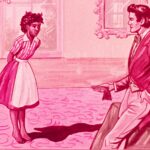Of course, many have critiqued Stowe by suggesting that her novel is an example of what queer theorists have called heteronormativity, the unspoken assumption that the world is properly organized into male and female domains and that differences in sexuality are defined as deviancy. I understand why critics have come to this conclusion. And yet viewing Hulton’s revision of Stowe’s novel renewed my belief that Stowe was communicating something important about the role of women in a culture defined by the violent behavior of men. Stowe’s politics can be read through Cassy: a model of maternal strength as a political force. Her sacrifice, like Uncle Tom’s, is martyr-like. Her body, all that she has, is a buffer that protects Emmeline and others from the violence Legree would otherwise have directed at them. The “maternal values” that Tompkins highlighted as the core of Stowe’s philosophy, her political “reworking,” is not heteronormative or even conservative. Instead, Stowe offers an ideal of maternal feelings that fuel political action. This is as brave as it is overlooked, and it is the very thing that Hulton erases from the filmstrip.
In short, when I looked back at the Uncle Tom’s Cabin filmstrip, I realized that Hulton’s anti-Communist project obscured the very thing that I had appreciated about Stowe’s novel: its commitment to maternal values, feminine sentimentality, and Christian virtue—a society remade in the archaic image of Christian motherhood. The literary scholar Jim O’Loughlin has suggested that Stowe’s use of “iconography” and “stereotypical” visual images means that in practice her novel is directly linked to the racist depictions that followed its publication: the minstrel shows and racist caricatures. And yet throughout the Uncle Tom’s Cabin class, I felt inexplicably, passionately defensive of Stowe. Sometimes, I found it almost painful to hear my classmates’ exhortations about Stowe’s “white saviorism,” her supposed ignorance and arrogance. Stowe’s commitment to Christianity was unapologetic. It was this absolutism that, in practice, drove her to challenge racial injustice.
Figures 12a-e: Scenes from Uncle Tom’s Cabin by Harriet Beecher Stowe part of Great Books Retold in Pictures. Click images to expand.
Stowe’s use of direct address is brilliant. Through it, she makes clear these revolutionary aims, and she draws the reader in, offers them a seat. Many complain about this stylistic device, one that links women’s narratives as diverse as Charlotte Temple (1791), The Color Purple (1982), and Fleabag (2016). I love it. I love these texts. Stowe, in conversation with her reader, exhorts her to change the world. There’s something lovingly matriarchal about exhortation, as if we are sitting around the kitchen table: well let me tell you, well I’ll tell you this, and so I said to her I said. This is Stowe’s mode of address when she speaks to “the Women of the United States of America” or when she calls out to “You, mothers of America, you who have learned, by the cradles of your own children, to love and feel for all mankind.” This is Stowe’s mode of address when she writes, “By the sacred love you bear your child . . . pity the mother who has all your affections, and not one legal right to protect, guide, or educate, the child of her bosom! . . . And say, mothers of America, is this a thing to be defended, sympathized with, passed over in silence?”
I maintain that you can’t really understand Stowe’s method unless you understand that kitchen table culture: women catching up over (what in England we would call) a cuppa. I feel we ought to understand Stowe’s exhortation as iced tea on the porch after Sunday service, while the husbands do whatever husbands do. “As a mother . . . ,” “Dear mothers”: she wasn’t writing to twenty-first century Liberal Arts students whose most active socialization occurs at Thursday night pre-drinks. She assumes the primordiality of Christianity and maternal values—even treats them as necessary. To what extent should our politics reflect our religion, our morals, our maternity? Absolutely and essentially, she answers.
Figures 13a-e: Scenes from Uncle Tom’s Cabin by Harriet Beecher Stowe part of Great Books Retold in Pictures. Click images to expand.
The Beacon filmstrip I discovered in Glasgow showed none of this. Instead, it depicted women in distress—always in distress, always helpless and crying, always defeated. In the filmstrip, enslaved Black women were pawns in the struggle between white authorities, just as, in The Picture Post, Korean and Arab women were “pawns” of Communism and the “Fashionable” game of “Cold War.” Hulton’s filmstrip company was a footnote in his larger political and economic project. In his 1952 autobiography, When I was a Child, Hulton offers a list of griefs, grievances, and thwarted ambition. He links world politics (“social revolution and total war”) to his own losses. In 1921, he lost his father and much of his father’s newspaper empire. His mother was “shattered” by her husband’s death. His sister died at age twenty-two. The “political advancement” that he had expected remained continually beyond his reach. He ran for Parliament twice as a Conservative, in 1927 and 1931, but lost both times. Hulton is in his autobiography beset from all sides by threats to his wealth, political ambition, and ideology.
Hulton remained ambitious. Hopkinson, the photographer Hulton forced to resign, observed that Hulton in the 1950s “had not yet altogether given up his pre-war parliamentary ambitions.” The filmstrip, then, imperfectly reflects the values of an ardent anti-Communist who had continued to nurture conservative political goals.


































